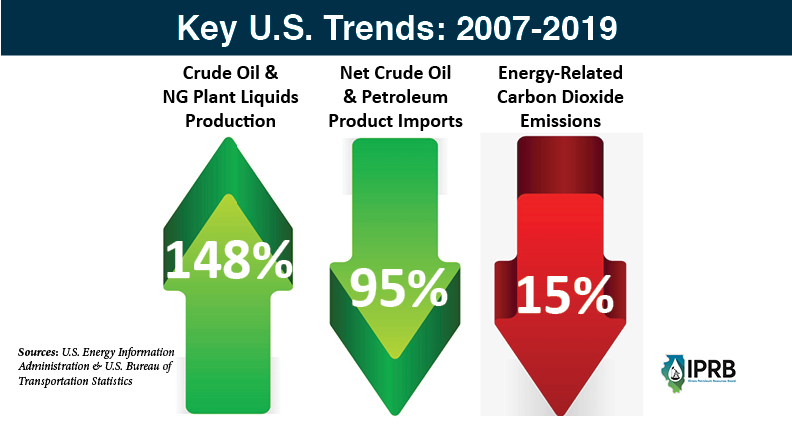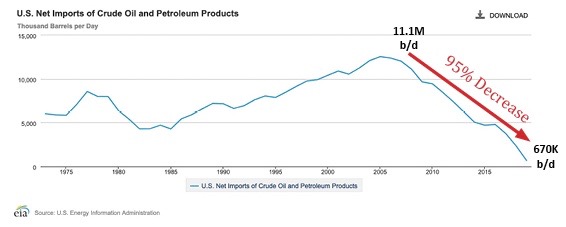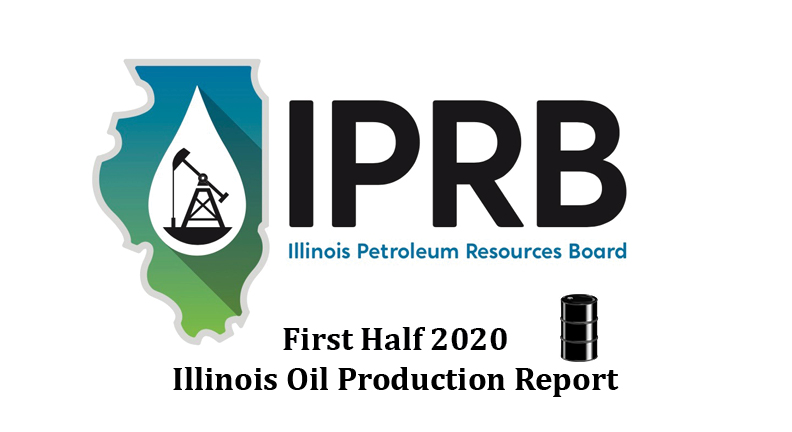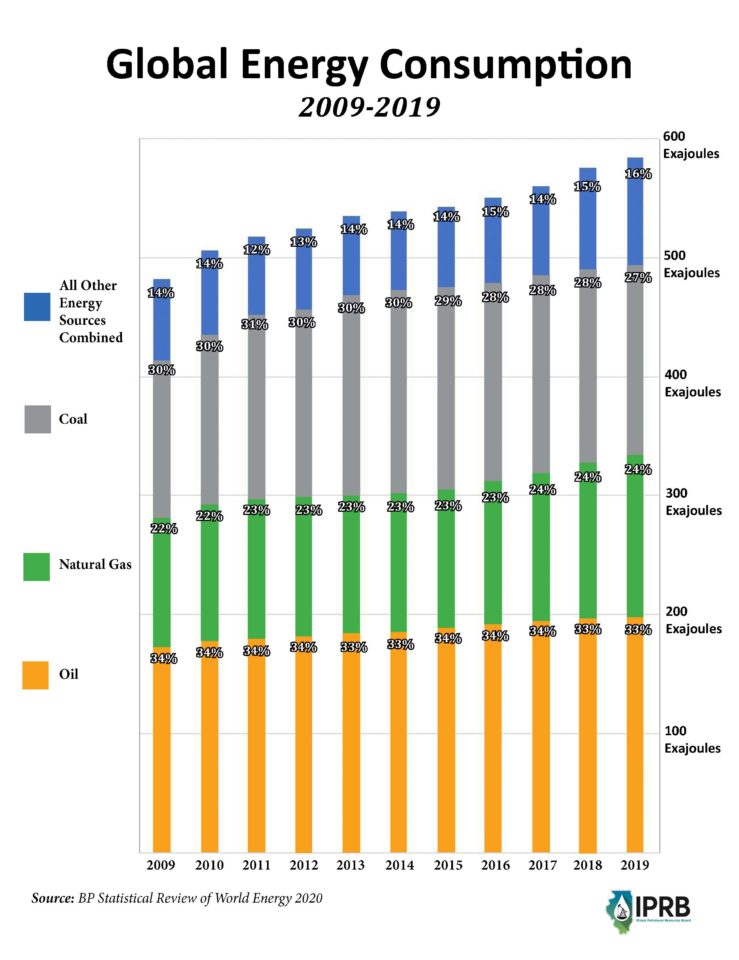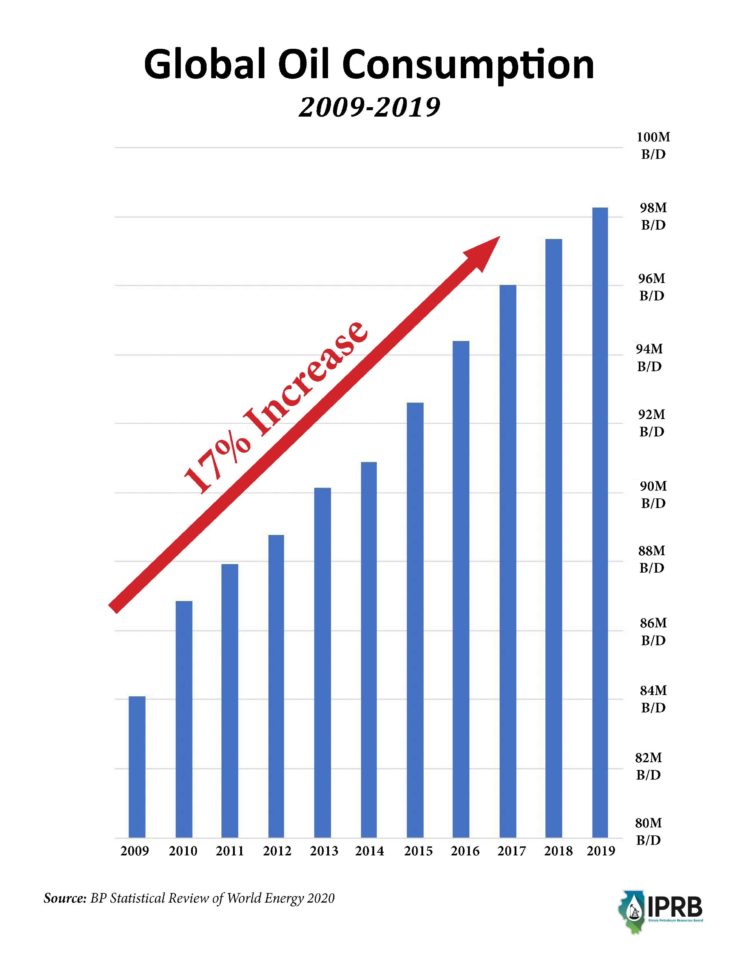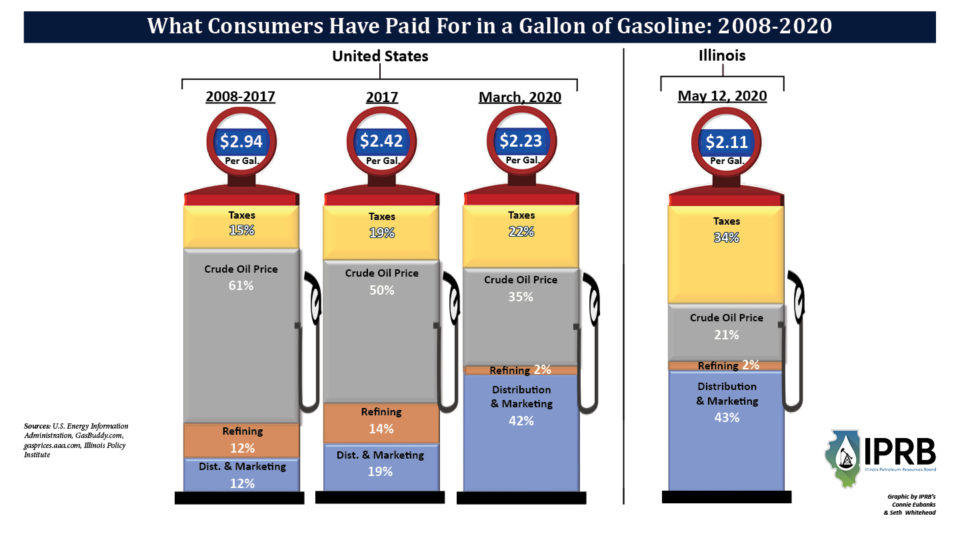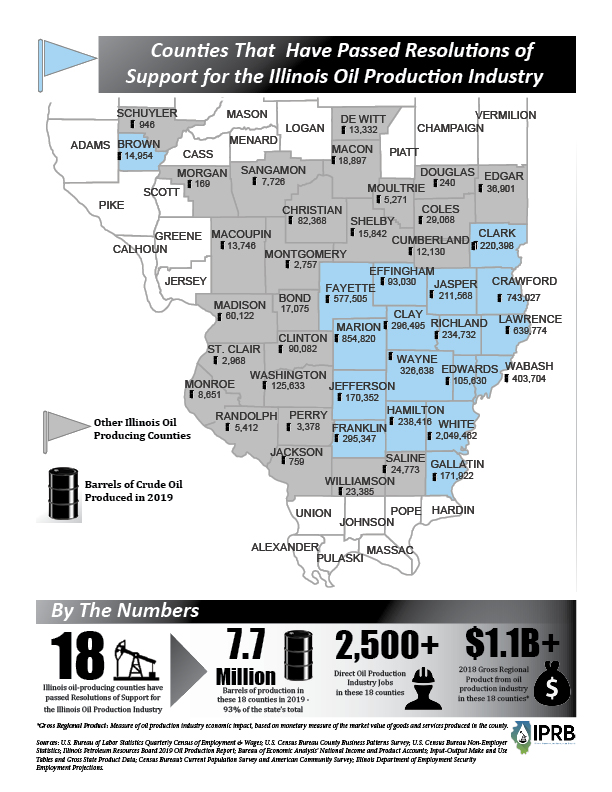Policies Aimed at Reducing U.S. Oil Production Will Only Increase Imports
Policies designed to deliberately decrease U.S. oil production have gained mainstream traction in recent years. The justification for such policies is the theory that curtailing domestic production will also drive down U.S. oil consumption and, subsequently, lower greenhouse gas emissions.
But a review of recent historical energy data shows that this widely held “Keep It In the Ground” belief has little basis in reality.
As the following IPRB chart shows, recent periods of decreased domestic petroleum production have coincided directly with sharp spikes in petroleum imports and CO2 emissions, while the recent spike in domestic petroleum production has coincided with plummeting imports and CO2 emissions.
 This data show that “Keep It In the Ground” policies would only increase petroleum imports, strengthening our foreign competitors geopolitical standing while weakening our energy security and economy – all while possibly lead to a rise in emissions to boot.
This data show that “Keep It In the Ground” policies would only increase petroleum imports, strengthening our foreign competitors geopolitical standing while weakening our energy security and economy – all while possibly lead to a rise in emissions to boot.
Case Study: 1986-2008 – Declining Production, Soaring Imports & Emissions
The longest period of sustained oil production decline in U.S. history – 1986 to 2008 – provides a perfect example of the fact that declining production does not lead to a reduction in domestic oil demand – it only leads into increased imports from oftentimes hostile foreign sources in order to meet demand. Oil consumption, petroleum imports and carbon dioxide emissions (CO2) all soared to record levels during this 22-year time period despite a dramatic decline oil production in the U.S.
Data from the U.S. Energy Information Administration (EIA) show that from 1986 to 2008, U.S. oil production declined 44 percent and overall petroleum production – including crude oil and natural gas plant liquids production – was down 36 percent. Based on the logic used to justify policies aimed at deliberately decreasing U.S. production, one might assume that U.S. oil consumption and carbon dioxide emissions declined as during this time as well. But the opposite was actually true.
CO2 emissions increased 27 percent during that time-span and despite free-falling domestic oil production, U.S. oil consumption increased 24 percent from 1986 to 2008. To meet oil demand, foreign imports of oil and petroleum products ballooned, and our net petroleum imports grew by a whopping 159 percent. In fact, the United States was the world’s largest oil importer in 2008.
As the following graphics show, U.S. energy and emissions trends during this period of time were troubling, to say the least.
Anybody who is old enough to legally have a beer probably remembers that the mid-to-late 2000s were a time of considerable angst on the domestic energy front. U.S. oil production dropped to just 5 million barrels per day in 2008 and “peak oil” fears became rampant. U.S. net petroleum imports peaked at 12.5 million barrels per day in 2005 and our carbon dioxide emissions reached all-time highs in 2007.
U.S. oil demand has continued to grow consistently since 2008. But fortunately, our domestic production and natural gas production has skyrocketed, allowing the United States to reverse the above trends and put us closer to our long-coveted goal of energy independence than anyone could have imagined just a decade ago.
But now, with oil demand artificially depressed by the COVID-19 pandemic, it is easy to forget that global oil consumption will likely rebound sharply once the pandemic is behind us. After all, global oil consumption reached an all-time high of nearly 100 million barrels per day in 2019, with the United States accounting for more than 20 percent of that consumption. The latter fact noted, the United States will no doubt return to the days of being the world’s leading oil importer if policies aimed at intentionally reducing domestic production are implemented.
That would be great news for major oil producing nations such as Saudi Arabia and Russia, who would no doubt regain the market share and geopolitical leverage they lost when the United States emerged as the world’s top oil producer this past decade.
And though it might seem counter-intuitive, a decrease in domestic oil and natural gas production would likely spike our CO2 emissions as well.
A dramatic increase in U.S. oil production over the past decade-plus has been coupled with a world-leading decline in CO2 emissions (nearly 800 million metric tons).
This can largely be explained by the fact that record U.S. production clean-burning natural gas – large quantities of which are co-produced with oil in places such as the Permian Basin in Texas and New Mexico – have allowed the United States to reduce emissions considerably.
Policies aimed at curtailing U.S. drilling will make natural gas more expensive and less plentiful and likely increase coal use, considering intermittent renewable energy is nowhere near reliable enough to power a developed society with a modern economy. Increased coal use would lead to a reversal in downward emission trends seen since about 2005.
Conclusion
It wasn’t that long ago that “peak oil” fears and the assumption that the United States would be under the thumb of the OPEC cartel for decades to come were prevalent. But thanks to the ingenuity of U.S. producers, we are now the world’s undisputed leader in oil and natural gas production, a net oil and natural gas exporter and have led the world in CO2 emission reductions this century.
Fortunately, many Americans recognize these facts and see the folly in policies that would reverse these trends. Recent polls show strong support domestic oil and natural gas production throughout the United States, including Illinois:
- A recent survey of 700 Illinois residents commissioned by the Grow America’s Infrastructure Now (GAIN) coalition finds 90 percent of respondents believe it’s important for the United States to be energy independent, while 85 percent agree that the oil and gas industry is important to the Illinois economy.
- A recent Morning Consult poll of respondents in 12 energy-rich states found that 64 percent of respondents are likely to vote for a candidate who “supports policies that ensure consumers continue to have access to natural gas and oil produced in the U.S.”
- A recent survey of 3,631 voters and likely voters across Iowa, Michigan, Minnesota, Ohio, Pennsylvania and Wisconsin conducted by the The Epoch Times found that 42 percent support “fracking [hydraulic fracturing] as a means of increasing oil and natural gas production in the U.S,” compared to 32 percent that oppose it.
As energy expert Daniel Yergin recently noted, “The world still runs on oil and oil will be a very major part of the energy mix for quite a long time… If you ban fracking [hydraulic fracturing] it’s an import-more-oil-policy.” Hopefully, policymakers will take note.
UPDATE: 5 Examples That Show ‘Keep It In the Ground’ Movement Isn’t Serious About Reducing Emissions
*UPDATE*
Aug. 20, 2020, 4:15 p.m.
As IPRB noted last week, “Keep It In the Ground” activists groups oppose the mineral mining needed to facilitate the massive renewable energy infrastructure build-out they claim is necessary to reduce greenhouse gas emissions and mitigate climate change.
A prime example of this contradictory stance can be found at the local level, as Southern Illinoisans Against Fracturing Our Environment (SAFE) has actively opposed proposed rare earth mineral mining at Hicks Dome in Hardin County and, more recently, potential rare earth mineral mining near Marion.
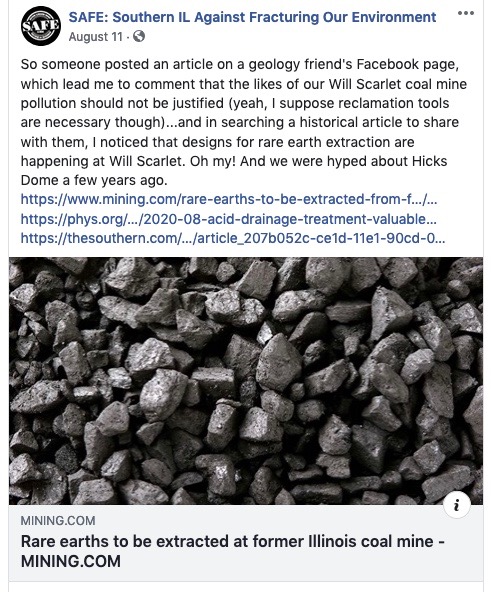
The Shawnee Trails chapter of the Sierra Club also expressed concerns about potential rare earth mining in a 2016 newsletter:
“Geological prospecting was proposed for Hick’s Dome in Hardin County in 2012, and the Forest Service received public comments during April and May 2015. Potential waste containment and health issues are of concern, whether during core drilling of radioactive rare earth elements (REEs), including thorium, or later possible mining. Moreover, IDNR just approved an oil drilling permit in Hicks Dome, which prompts similar concerns. REEs are used in electronics, hybrid vehicles, wind turbines, and cell phones. China supplies most REEs presently. Read the Project Documents and about REEs and environmental issues.”
Any serious transition to renewable energy is going to require some increase in mineral mining in the United States, including in Illinois. Opposition to such projects can effectively be viewed as indirect opposition to renewable energy or an endorsement of “not in my backyard” outsourcing of mining to other countries. IPRB will monitor these group’s stances on such issues in the months ahead.
Original Post: Aug. 13, 2020
“Keep It In the Ground” (KIITG) activists claim a rapid transition to 100 percent renewable energy is absolutely necessary in order to dramatically reduce greenhouse gas emissions and mitigate climate change. But such a transition would require a lot of mining, lots of natural gas to back up intermittent wind and solar, and dramatic reform of federal permitting protocols to facilitate a rapid renewable infrastructure build-out.
Leaders of the KIITG movement are diametrically opposed to all three of these things.
KIITG movement leaders also show a relative lack of concern about skyrocketing carbon dioxide (CO2) emissions in China, while one of the movement’s most prominent communities continues to focus on suing energy companies more than actually reducing its own sky-high emissions. Add it all up, and it’s clear most KIITG activists care more about ending all U.S. energy production and making the United States completely dependent on foreign energy sources than reducing emissions and addressing climate change.
Here’s a closer look at the five examples of why the movement deserves far more scrutiny than it gets.
Example #1: KIITG Groups Oppose Reforms That Would Expedite Renewable Energy Projects
It has been estimated that 25 to 50 percent of overall U.S. land mass would be required to facilitate the wind and solar energy infrastructure build-out necessary to achieve the KIITG movement’s renewable energy goals by 2030.
That massive acreage considered, such a build-out is simply not going to happen without major reform of the restrictive National Environmental Policy Act (NEPA). NEPA currently requires extensive environmental reviews to be conducted prior to major infrastructure projects beginning. These reviews currently take an average of more than 4 1/2 years to complete and can delay projects as many as 10 years, as such reviews are routinely challenged by environmental groups. These delays have been a major roadblock for both fossil fuel andrenewable infrastructure projects for years.
That is why President Trump recently signed an executive order to reform NEPA and expedite major infrastructure projects. The wind industry applauded Trump’s overhaul for the reasons noted above. But KIITG groups such as the Natural Resources Defense Council (NRDC) vehemently oppose Trump’s NEPA reforms, claiming they will undermine environmental protections. Former Obama-era U.S. Environmental Protection Agency (EPA) chief and current NRDC President Gina McCarthy recently said in a statement:
“These reviews are required by law to protect people from industries that can harm our health and our communities. Getting rid of them will hit those who live closest to polluting facilities and highways the hardest – in many of the same communities already suffering the most from the national emergencies at hand.”
KIITG opposition to NEPA reform is a textbook example of the disconnect between the movement’s pie-in-the-sky idealism and the real-world compromises needed to make its 100 percent renewable energy rhetoric a reality. It is just one reason that the rhetoric has no basis in reality.
Example #2: KIITG Groups Oppose Mining Needed For Renewable Infrastructure
The 100 percent renewable energy transition KIITG groups insist must happen this decade is also going to require massive increase in mineral mining to produce renewable energy infrastructure and components such as batteries and solar panels. But prominent KIITG groups are diametrically opposed to mining – especially mining in the United States.
The Sierra Club’s mining policy states:
“Mining by its very nature is a dirty business and highly disruptive of the natural and human environment… Because of these negative impacts, additional or new mining must be kept to a minimum to meet essential human needs and alternatives to mining undisturbed ore bodies should be encouraged and pursued.”
Earthworks has a similar stance, characterizing mining as “inherently destructive” while stating that mining “devastates communities, clean water and the environment.”
It is because of well-funded campaigns by KIITG groups such as the Sierra Club and Earthworks that United States mineral mining is currently being “kept to a minimum” and far below the levels needed to domestically source the type of renewable energy revolution KIITG activists insist is needed.
Key minerals for the renewable energy transition include cobalt, lithium, natural graphite, nickel and rare earth metals, all of which are essential to manufacture batteries and components for electric cars.
According to a recent report from researchers at the Institute for Sustainable Futures at the University of Technology Sydney in Australia, a 100 percent renewable energy transition would increase global lithium demand 280 percent and nickel demand 136 percent. The report finds that even assuming a high rate of recycling, demand for the two metals would exceed existing reserves by 86 and 43 percent, respectively, necessitating a massive increase in new mining.
Cambridge University Emeritus Professor of Technology Michael Kelly has estimated that replacement of the United Kingdom internal combustion engine vehicles alone with electric vehicles would require more than half the world’s annual copper production, twice of its current cobalt production, 75 percent of its annual lithium carbonate production and nearly the world’s entire current production of neodymium.
The United States produces just 12.4 percent of the world’s rare earth metals, just 1.2 percent of the world’s lithium and virtually no cobalt and natural graphite.
In contrast, China controls 90 percent of global rare earth production, 90 percent of cobalt refining and 60 percent of global natural graphite production. Sixty-four percent of cobalt mining takes place in the Democratic Republic of the Congo and is largely controlled by Chinese companies.
Manhattan Institute senior fellow Mark P. Mills has also noted that:
“America imports some 80 percent of the electrical components (i.e., the key stuff other than the concrete, steel, and fiberglass) used in wind turbines. About 90 percent of our solar panels are imported. And even if solar cells were fabricated here, the U.S. produces only 10 percent of the world’s essential underlying silicon material. China produces half.”
Suffice it to say, the United States would be heavily dependent on China should the 100 percent renewable energy transition KIITG groups are pushing for commence any time soon. Such a situation would likely result in the renewable energy equivalent of the United States being under the OPEC oil cartel’s thumb, as it was for many decades prior to America’s recent oil and natural gas renaissance. As Ashley Feng, a research associate for China studies at the Council on Foreign Relations, recently wrote in Scientific American:
“In the clean energy economy of the future, critical minerals will be just as essential – and geopolitical – as oil is today. To avoid making the same mistake twice, the U.S. should preemptively [declare] its own clean energy independence.”
But that would require powerful KIITG groups to suddenly shift policy in support of domestic mineral mining expansion in places such as Round Top in Texas, which is believed to hold a 130-year supply of rare earth minerals. But don’t hold your breath on that KIITG policy shift announcement.
Example #3: KIITG Groups Oppose Natural Gas and Nuclear Energy
Increased use of natural gas – which emits roughly half the CO2 of other traditional fuels when burned – is the No. 1 reason the United States leads the world in CO2 reductions this century.
 Nuclear energy is the only zero-emission power source that has been deployed at scale. An overwhelming majority of the CO2 emissions reductions achieved by the United States and Europe this century simply would not have happened without natural gas and nuclear energy.But KIITG groups oppose both.
Nuclear energy is the only zero-emission power source that has been deployed at scale. An overwhelming majority of the CO2 emissions reductions achieved by the United States and Europe this century simply would not have happened without natural gas and nuclear energy.But KIITG groups oppose both.
A fact sheet that was released as part of the Green New Deal (GND) rollout calls for nuclear phase-out (although unproven “advanced” nuclear has since been tepidly endorsed by more moderate GND advocates). However, the Sierra Club, Food & Water Watch, Earthworks, NRDC and many other major KIITG groups outright oppose nuclear energy, as does teen climate activist Greta Thunberg. KIITG groups and activists also overwhelmingly favor banning hydraulic fracturing – the technology that has made natural gas more abundant and affordable than any time in history.
This opposition is baffling, as any serious effort to dramatically reduce emissions would almost certainly need to an all-of-the-above approach including natural gas, renewables, nuclear and some form of carbon capture and storage.
Example #4: KIITG Groups Praise China Despite Its Soaring Emissions
Not only would the United States likely be heavily reliant on China for the minerals needed to facilitate a 100 percent renewable energy build-out, the emission reductions that might result from such a build-out would be far offset by China’s exploding emissions.
As the above IPRB graphic illustrates, CO2 emissions increases in China have outpaced emissions reductions in the top-five leading countries this century by 472 percent.
Simply put, the world has no hope of collectively significantly reducing GHG emissions if China’s current emissions trajectory continues. And chances are, that trajectory is going to continue.
China is building hundreds of high-emitting coal power plants while watching its CO2 emissions skyrocket, the exact opposite of what is happening in the U.S., where natural gas plants have replaced more than 100 coal plants since 2011.
https://twitter.com/EIAgov/status/1290981076165427204
E&E News recently reported that:
“Today, [China] has almost as much new coal generation in planning or construction (206 gigawatts) as the United States has in operation (235 GW at the end of 2019).”
Christine Shearer, who runs the coal program at Global Energy Monitor, a research group that tracks fossil fuel infrastructure, told E&E News in an email:
“China’s coal plant build-out could single-handedly undermine the reductions in coal power use that the IPCC [Intergovernmental Panel on Climate Change] has said are necessary to keep warming below 2C, even if the rest of the world phased out coal power by 2030.”
Despite these facts, KIITG groups and the mainstream media routinely applaud China’s efforts to address climate change. As Bloomberg reported in 2017:
“The nation that spews the most pollution and is building dozens of coal-fired power plants is also winning accolades from the likes of Greenpeace and WWF for its efforts to fight global warming and steer an environmental path away from fossil fuels.”
Clearly, any serious campaign to reduce global CO2 emissions and mitigate climate change should be focused on China. Instead, KIITG groups either laud China or choose to ignore its skyrocketing emissions while pushing to ban domestic production of fossil fuels that are responsible for 80 percent of our energy mix.
Example #5: KIITG Groups Focus on Suing Energy Companies Rather Than Reducing Emissions
KIITG groups have pushed numerous climate liability lawsuits throughout the United States in recent years, a tactic aimed at forcing energy companies to pay for the impacts of climate change and adaptation measures, with a long-term goal of putting targeted companies out of business.
One of the most infamous climate lawsuits has been filed by the city of Boulder, Colo., which is known for touting its green credentials and being the epicenter of Colorado’s KIITG movement. But it turns out Boulder’s “green” credentials aren’t exactly much to brag about.
The Associated Press (AP) recently reported that a Boulder County zip code has the highest per-capita carbon dioxide (CO2) emissions in the country. That’s right – the average resident of this “green” KIITG hot-spot uses far morefossil fuels than the typical American. As the AP reported:
“The zip code that produced the most greenhouse gas per person was in the mountains of western Boulder County, where the 23,811 pounds per person is 18 times higher than in the San Francisco zip code.”
Boulder County’s gluttonous fossil fuel consumption even as the city of Boulder sues energy companies is more than just hypocritical. It shows that even if the KIITG the strategy of suing U.S. energy companies out of existence were to prove successful, it is highly unlikely that affluent, energy-hungry communities such as Boulder where the KIITG movement tends to be most prominent will simply continue using energy sourced from foreign sources.
Conclusion
With the KIITG agenda going mainstream in this year’s presidential election, that agenda certainly warrants increased scrutiny. And as the five examples above illustrate, it is clear that the KIITG agenda has much more to do with putting U.S. traditional energy companies out of business and making the United States completely reliable on foreign energy sources than it does with reducing CO2 emissions and mitigating climate change.
Thanks largely to the United States’ oil and natural gas renaissance, America’s energy security is as strong as it’s ever been and once unimaginable energy independence is within reach. The KIITG agenda simply seeks to destroy that energy security by making the United States dependent on foreign sources for oil and natural gas andminerals needed for a massive renewable energy build-out.
Illinois Oil Production Bounces Back to Normal Levels After Rough Spring
NOTE: This blog was updated on Aug. 7, 2020, with revised June production data.
Illinois crude oil production in the first half of 2020 was 8.3 percent below levels seen in the first half of 2019, totaling 3,663,050 barrels. However, Illinois oil output returned to more typical pre-COVID-19 pandemic production levels in June.
COVID-19 restrictions drove down oil demand and prices at an unprecedented pace throughout the world in the spring. So not surprisingly, Illinois oil production was down 27 percent in the second quarter compared to first-quarter production totals, and overall United States oil production experienced a similar decline, falling by 22 percent (2.8 million barrels per day).
But Illinois production in June increased 93 percent from May’s production level of just 11,987 barrels per day (bpd), settling at a more typical 23,025 bpd.
Though oil prices and production are trending in the right direction, there is no getting around the fact that it was a tough second quarter.
April production was down 30 percent from typical Illinois production of 23,000 bpd, as Illinois Basin oil prices averaged just $12.68 in the wake of the global demand crash brought on by the COVID-19 pandemic.
Prices improved considerably in May and were up 147 percent from their April lows in June. But although prices have remained steady throughout July, they are still well below levels seen early in 2020.
Despite the oil price crash, White County is still on pace to surpass two million barrels of annual production for the second consecutive year, pumping 1,076,144 in the first half of 2020. That total represents 29 percent of the state’s total production so far this year.
Many experts are cautiously projecting a steady rebound in oil demand throughout the rest of 2020, providing hope that the worst of the COVID-19 price collapse has passed.
Click here to view IPRB’s full production report for the first half of 2020, including county-level totals. Production data is compiled by IPRB from monthly reports submitted by Illinois Basin first purchasers.
Fact Checking the Indianapolis Star’s Misleading Story on PPP Loans to Fossil Fuel Companies
A recent Indianapolis Star article claims Indiana fossil fuel companies “may have gobbled up more than their share” of Paycheck Protection Program (PPP) loans designed to help businesses through the COVID-19 pandemic and that “clean energy was left behind.”
As the story’s headline suggests, the article strongly implies renewable energy companies were flat-out denied PPP loans by the Trump administration while fossil fuel companies received inordinate levels of relief.

However, there is simply no evidence presented in the article to back up those assertions. Here are the most egregious claims made in the article, followed by the facts.
CLAIM: “Indiana coal, gas and oil companies may have gobbled up more than their share of the government loans meant to help companies deal with the pandemic.”
FACT: The article doesn’t include a single example of an Indiana fossil fuel company receiving a loan larger than it was eligible to receive or a loan that it should not have received at all.
The article emphasizes that Indiana fossil fuel companies received between $42-$100 million in PPP loans, but doesn’t indicate that total exceeded any specific threshold that would raise a red flag. Instead, the reporter relies on vague speculation from “environmental advocates” to reach the subjective conclusion that the loans were excessive. As the following excerpt from the story shows, the speculation from "environmental advocates" has more to do with anti-fossil fuel advocacy than the alleged misappropriation of funds the reporter suggests occurred.
“For many environmental advocates, the Paycheck Protection Program data calls into question the number and size of relief funds allocated to an industry that was on the decline before the pandemic.”
CLAIM: “[C]lean energy was left behind.”
FACT: The story actually notes Indiana “clean” energy companies received millions in loans and doesn’t quote a single “clean” energy company representative claiming their PPP loan application was either denied or that loan they received was inadequate.
Oddly, the story’s two primary sources were not renewable energy company representatives. Instead, the reporter quoted representatives from the Indiana Renewable Energy Association (IREA) and the Sierra Club. The latter actively advocates for “Moving Beyond Dirty and Dangerous Fossil Fuels.”
One would think that a piece centered on the notion that clean energy companies were “left behind” would reach out to a representative from one of those companies to provide testimonial to support that claim.
Instead, IREA head Laura Arnold suggests the PPP monies should have been used to “set up to transition fossil fuel workers into other industries,” suggesting that the monies should have been “better used for a more viable industry.” Again, this is an example of anti-fossil fuel advocacy rather than an accusation of misappropriation of government monies.
And speaking of monies, the reporter’s conclusion than “clean” Indiana energy companies received “less than $5 million” is somewhat misleading as well. As the story notes:
“Only a handful, however, of Indiana companies in renewable energy received loans, according to the data. …
“Morton Solar & Wind and Midwest Wind & Solar each received between $150,000 to $350,000. One other, Inovateus Solar, got between $350,000 and $1 million. Other renewable or clean energy companies in Indiana may have received money, but it was not immediately apparent in IndyStar’s analysis of the data.”
Because PPP loans of $150,000 or less were not disclosed in data released from the White House and loans of more than $150,000 were presented in broad ranges, exact PPP loan figures for both the fossil fuel and “clean” energy were impossible to calculate. But that didn’t keep the reporter from deliberately presenting high-end estimates for fossil fuel loan recipients and more conservative estimates for “clean” energy companies.
CLAIM: The fossil fuel industry “was on the decline before the pandemic.”
FACT: Far from being in decline, fossil fuels supply 94 percent of Indiana’s energy.
As the following U.S. Energy Information Administration (EIA) graphic illusrates, Indiana relies heavily on fossil fuels to meet its energy needs.
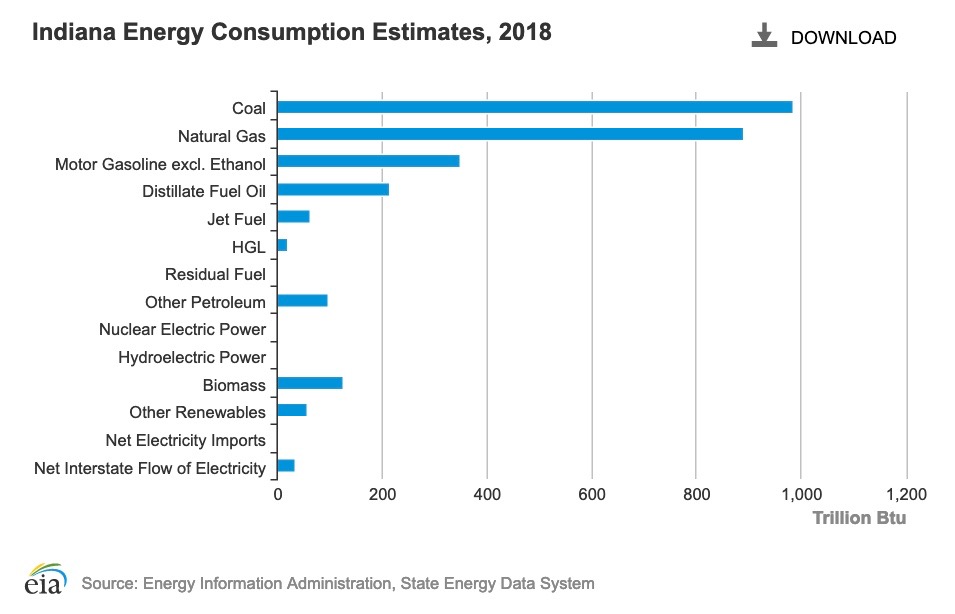
To suggest an industry that supplies 6.7 million Indiana residents with an overwhelming majority of the energy they rely on to power their lives is “in decline” is spurious at best.
The above graphic illustrates why Indiana governor Eric Holcomb – like many governors from both sides of the political aisle across the United States, including Illinois Gov. JB Pritzker – designated the oil and natural gas industry as “essential” when COVID-19 pandemic restrictions began.
CLAIM: “Clean energy has been a booming industry in recent years and those jobs outnumber fossil fuel workers 3-to-1….”
FACT: The definition of “clean” energy jobs is very broad, inflating the total number of jobs in the industry.
The above claim is based Clean Jobs America report that identifies more than 3.2 million “clean” energy jobs. But a close look at the report reveals that more than 2.3 million (72 percent) of those jobs are “energy efficiency jobs,” which includes traditional HVAC positions and “high efficiency” HVAC positions. Wind and solar energy jobs make up just 14 percent of the 3.2 million “clean” energy jobs identified.
Similarly, a recent Clean Jobs Midwest report claims there were 86,800 “clean” energy jobs in Indiana before COVID-19, “five times as many” as in the fossil fuel industry in the state, according to one media report.
But a close look at that report reveals that 64 percent those 86,800 “clean” energy jobs are energy efficiency occupations, including 14,000-plus traditional HVAC positions and another 24,456 high efficiency HVAC positions. In fact, 863 natural gas "advanced transportation" jobs are listed among the “clean” energy jobs even though they should clearly be classified as fossil fuel jobs. Of the 86,800 total “clean” energy jobs identified in the report, 10,975 are in renewable energy. The latter figure is similar to the number of fossil fuel industry jobs in the state, 7,391 of which are in the oil and natural gas industry, according to Texas Independent Producers and Royalty Owners 2020 State of Energy Report. The American Petroleum Institute estimates the oil and natural gas industry supports 10.3 million U.S. jobs overall.
Conclusion
To be clear, the COVID-19 crisis has been devastating to the entire energy industry, resulting in hundreds of thousands of jobs losses combined across all sectors. Fortunately, the PPP loan program has alleviated some of the pain. That said, it is disappointing to see a media report that suggests it was borderline criminal to provide loans to fossil fuel companies that meet 94 percent of Indiana's energy needs. Providing a platform for groups that feel PPP monies would have been better used to “set up to transition fossil fuel workers into other industries” that currently supply just three percent of Indiana’s energy seems more than a little tone deaf as well.
Now more than ever, Americans need access to affordable, reliable energy. What it doesn’t need is advocacy journalism aimed at misleading the public about a fossil fuel industry that can largely be credited for both of those things.
Report Shows Oil Consumption Reached All-Time High in 2019
It has become quite fashionable to claim that the age of oil is all but over and that fossil fuel industries are in a rapid state of decline. But the facts simply do not support that rhetoric, with data from the recently released BP Statistical Review of World Energy 2020 being just the latest example.
The highly regarded report finds that global oil consumption reached an all-time high in 2019 and was the top source of energy in the world – a title it has held since the early 1960s. Oil’s resilience along with the continued ascension of natural gas use can explain why fossil fuels collectively supplied a whopping 84 percent of the world’s energy last year despite the continued decline of coal use.
In fact, as the following IPRB chart shows, oil and natural gas’ share of the overall global energy mix has remained remarkably consistent over the past decade-plus, ranging between 56 and 57 percent each year, while the overall fossil fuel share of the global energy mix has remained between 84 and 87 percent.
For perspective on how little the energy mix has actually changed despite all the hoopla about renewable energy growth, fossil fuels had the exact same 84 percent share of the overall global energy mix way back in 1973.
How can this be considering renewable energy accounted 41 percent of the total share of increased energy use in 2019? Simply put, overall global energy consumption growth has outpaced renewable energy growth. And despite the aforementioned narrative that oil demand is in decline, oil consumption has increased each of the past 11 years as well, as the following IPRB chart shows.
To put it bluntly, the oil and natural gas industry is not dying – far from it. And world's seemingly unquenchable thirst for energy is the primary reason why the outlook for the industry is strong.
Though oil and natural gas’ share of the overall energy mix may decrease in the coming years, raw consumption of both fuels will likely increase as more and more people gain access to the modern energy that we in the United States take for granted.
It has been conservatively estimated that 74 percent of the world’s population lives in underdeveloped nations with limited access to reliable energy, while more than a billion people live in energy poverty, meaning they have no access at all to modern energy, most notably electricity. However, the International Energy Agency (IEA) expects that to change in the decades ahead, which is why the IEA forecasts that global oil demand will continue to increase through at least 2040 as more and more poor countries develop modern economies. It also expects the United States to meet 70 to 80 percent of the roughly 10 million barrels a day of added oil demand through 2030.
And although consumption from all energy sources is set to see a big decline in 2020 due to the coronavirus pandemic and dramatic slowdown in economic activity, the IEA expects it to be more a blip than long-term trend. The IEA expects oil demand returning “where it was, and beyond” as the world gradually lifts COVID-19 restrictions that have slowed global economic growth.
And even assuming 100 percent Paris Climate Agreement compliance, 48 percent of global energy will come from oil and natural gas by 2040. That explains why a recent New York Times analysis concludes that even if aggressive greenhouse gas emission reduction policies are implemented throughout the world, “the petroleum industry will have to find about 4.5 million, instead of seven million barrels a day of new production every year.”
The U.S. Department of Energy (DOE) has also released a report that shows fossil fuels – primarily oil and natural gas – will likely meet 79 percent of our energy needs in 2050. That represents just a one percent decline from fossil fuels’ U.S. energy consumption share last year.
The data and expert analysis doesn’t lie: The world is going to need a lot of oil and natural gas for many years to come. And it makes sense to produce as much of it as possible in Illinois and throughout the rest of the United States than to rely on more environmentally lax and potentially hostile nations for the energy the world needs.
Three Reasons Illinois Gasoline Prices Didn’t Crash Along With Oil Prices
UPDATE: May 13, 2020, 3:25 p.m. CDT
Data released this week by the U.S. Energy Information Administration show that 64 percent of the retail price of a gallon of gasoline across the country in March could be attributed to taxes and marketing and transportation costs. As the following IPRB graphic shows, pump prices attributable to taxes and marketing and transportation costs has increased significantly over the past 12 years, while the share attributable to oil prices and refining costs have declined. The trend is even more pronounced in Illinois, where 77 percent of the price at the pump on May 12 could be attributed to taxes and marketing and transportation costs.
Editors Note: Original blog published on May 7, 2020, was updated on May 13, 2020, with new supplementary information from the Energy Information Administration
In the wake of the recent oil price crash that resulted due to the demand shock created by the coronavirus pandemic, many Illinois consumers may be wondering why gasoline prices haven’t declined as sharply as the price of oil did.
Though the average Illinois retail gasoline price sat at $1.79 per gallon on April 29 – the lowest average Illinois pump price in recent memory – it was still well above the average cost in many neighboring states.
Here are three reasons Illinois pump prices haven’t necessarily reflected extremely low domestic oil prices over the past few weeks.
Reason #1: High State Taxes
State, federal and local gasoline taxes in Illinois total 72 cents per gallon combined (and even higher near Chicago), meaning that roughly 40 percent of Illinois pump prices in late April were attributable to taxes.

Illinois’ state gasoline tax doubled last summer from 19 to 38 cents per gallon and is now the third highest state gasoline tax in the country. That total piles onto the 18.4-cent per gallon federal excise tax and 15-to-17-cent per gallon of local taxes paid by Illinois drivers. So no matter how low the price of oil goes – and it went as low as it could go on April 21 – retail gasoline prices in Illinois could fall no lower than 72 cents per gallon.
Reason #2: Global Crude Standard Drives Pump Prices
Another reason Illinois gasoline prices didn’t completely crash when the domestic oil price standard – the West Texas Intermediate (WTI) – went below $0 on April 21 is because refined products such as gasoline are traded on the world market and are determined by global market prices, namely, the global Brent crude index.
As the following Oilprice.com chart shows, though the Brent price dropped dramatically on April 21, it came nowhere close to the freefall the WTI experienced.
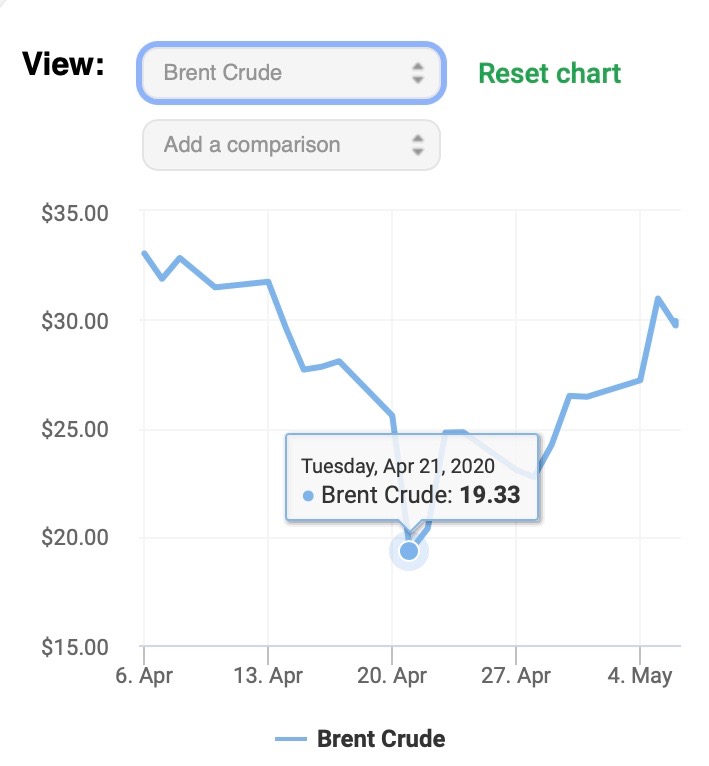
Brent prices have also remained higher than the WTI standard throughout the COVID-19 pandemic, continuing a trend that has generally been observed in recent years.
Notably, U.S. crude exports have kept Brent prices – and, by extension, pump prices – lower than they otherwise would have been by adding supply to the global market and thwarting OPEC’s once tried-and-true efforts to keep prices artificially inflated.
Prior to the U.S. oil production renaissance that has been ongoing for the few years, Brent oil prices averaged nearly $100 in 2008 and remained near that level through 2014. Not coincidentally, gasoline prices were routinely over $3 a gallon during that time, and went over $4 a gallon in 2011.
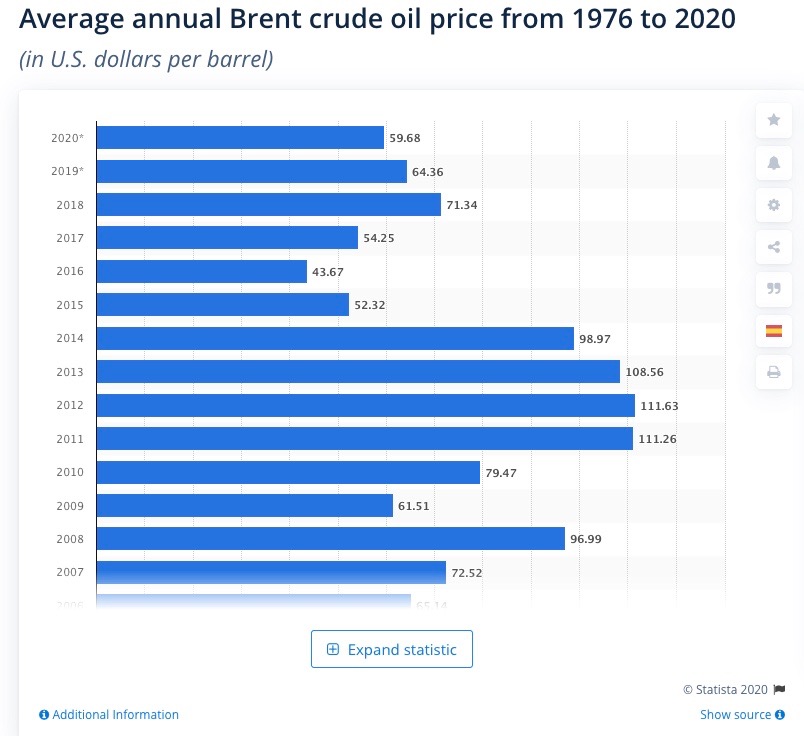
But after the crude export ban was lifted in 2015, Brent oil prices declined dramatically, driving down the overall cost of gasoline and the share of retail gasoline costs attributable to oil prices, as the following Energy Information Administration graphics illustrate.
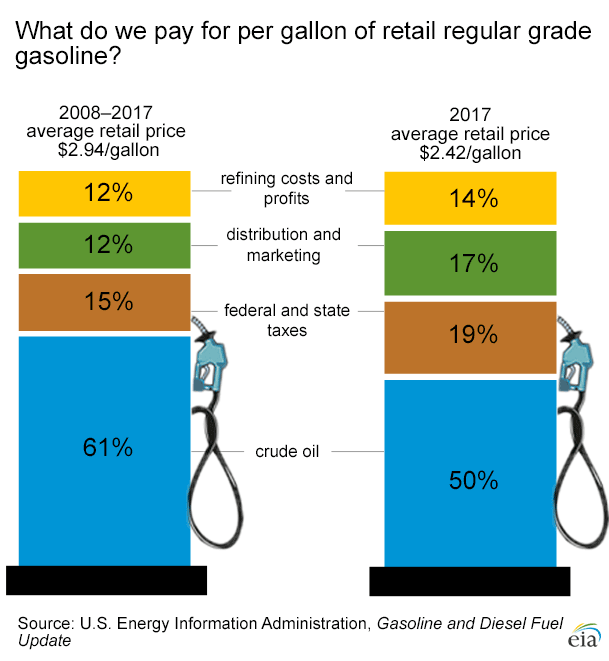
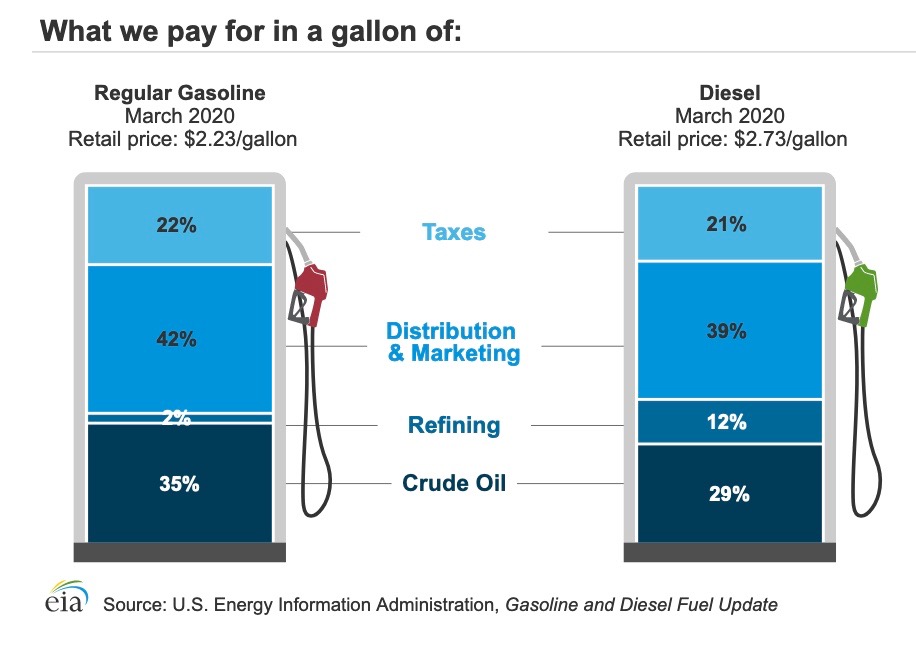
As the latest EIA graphic shows, global oil prices represented just 35 percent of the total cost of gasoline across the nation in March, compared to an average of 61 percent from 2008 to 2017.
Reason #3: Refining, Transportation and Marketing Costs Part of Equation
The third factor that explains why pump prices didn’t bottom out completely along with domestic oil prices last month are the necessary refining, distribution and marketing costs that are included. Marketing and transportation costs have ranged between 25-42 percent of pump costs from 2008 to the present.
Notably, local refining can reduce the cost of transporting gasoline to the market, reducing prices at the pump as well. The latest EIA data show that refining costs have declined dramatically since 2017 along with crude oil prices, while taxes and marketing and distribution costs have grown sharply.
Conclusion
The fact that the United States has emerged as the world’s top crude oil producer and a major exporter explains why the average American household has paid $500 a year less for gasoline each year since 2014. As USA Today recently reported “$3-a-gallon gasoline is becoming a distant memory” and “the main reason is the nation’s oil boom.” But the fact that gasoline taxes have generally increased – especially in Illinois – is the primary reason pump prices haven’t dropped even more. Essentially, increased taxes and marketing and transportation costs are the primary reasons why $1-a-gallon gasoline - even when the price of oil hits rock bottom - are a distant memory as well.
*UPDATE* Illinoisans Express Strong Support for State’s Oil Industry
UPDATE: May 1, 2020
A total of 18 Illinois oil-producing counties have passed resolutions of support for the state’s oil production industry over the past calendar year. Collectively, the oil production industry in these 18 counties are responsible for 7.7 million barrels of annual production – 93 percent of the state’s overall production – 2,500-plus direct oil production industry jobs and more than $1.1 billion in annual gross regional product. Check out IPRB’s new infographic for more details.
Gallatin County recently passed a resolution of support for the Illinois oil production industry. A total of 18 oil-producing counties have passed resolutions of support for the Illinois oil production industry over the past calendar year. Collectively, these counties accounted for 93 percent of Illinois oil production in 2019.
ORIGINAL POST: Jan. 30, 2020
Though it hasn’t gotten much attention, Illinois residents have demonstrated strong support for the Illinois oil industry in recent months.
Most recently, a survey of 700 Illinois residents commissioned by the Grow America’s Infrastructure Now (GAIN) coalition showed that a vast majority of Illinoisans recognize the importance of the industry to the state’s economy and endorse the United States’ continued march toward energy independence. As the Williston Daily Herald (North Dakota) reported:
“The poll found that Illinois residents not only support [expansion of the] Dakota Access [Pipeline], but the energy industry in general. Ninety-percent said they believe it’s important for the United States to be energy independent, while 85 percent agreed that the oil and gas industry is important to the economy in Illinois.”
Additionally, 17 Illinois oil-producing counties over the past several months have passed Resolutions of Support for the Illinois Oil Production Industry. Collectively, these 17 counties account for 90 percent of the state’s more than 8 million barrels of annual oil production.
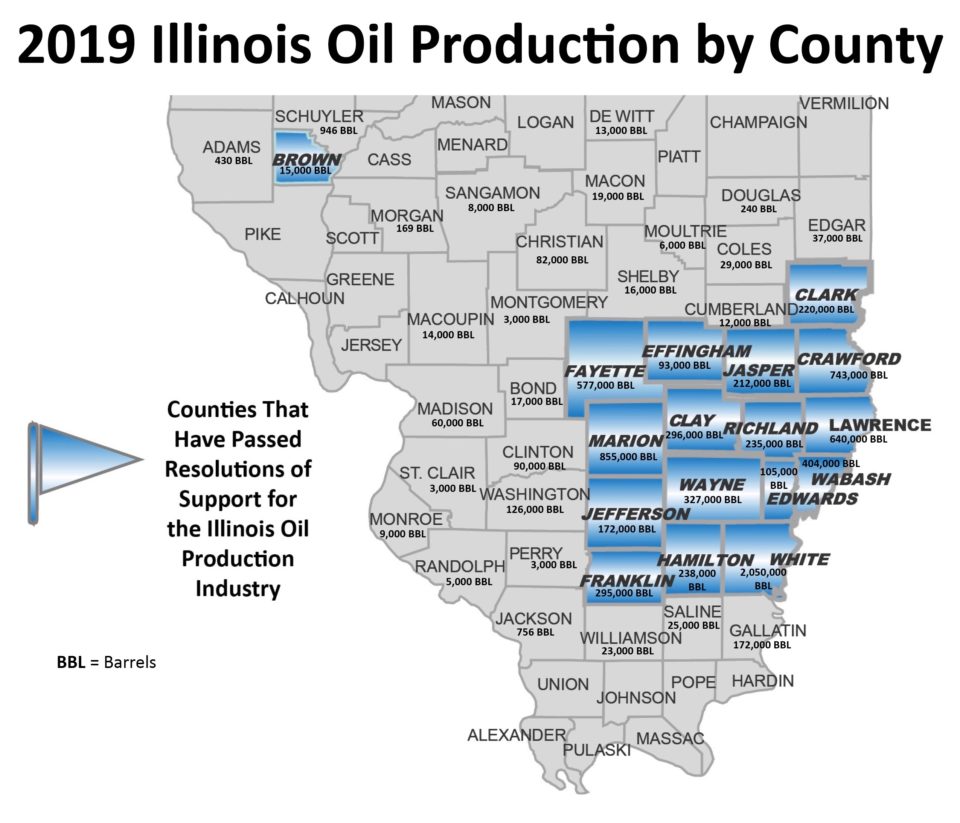
These non-binding resolutions formally express that the respective county boards support and encourage the presence and further growth of the oil production industry in their county. The resolutions recognize the thousands of jobs the industry creates and supports in these counties, and the millions of dollars in sales and property tax revenues the industry generates.
The passage of these resolutions directly counter the common misconception that oil and natural gas development is widely unpopular.
“Every year the industry is attacked by outside groups who seek legislation that would effectively put a vital economic engine out of business,” Illinois Oil and Gas Association (IOGA) President Bryan Hood said. “These resolutions demonstrate that folks from the region of the state where production actually occurs are not in favor of policies that would adversely impact the industry.”
As IPRB has highlighted before, the Illinois oil production industry is responsible for more than 4,000 direct jobs – supporting more than 14,000 Illinois jobs overall – generating $770 million in annual personal and business income. The industry also generates $330 million in annual state tax revenue and $3 billion in overall economic impact in the Land of Lincoln. A vast majority of Illinois’ direct oil production industry jobs are based in the counties that have passed the above resolutions, while more than $82 million in local property tax revenues were generated from 2007-2018 in those 17 counties.
“The passage of these resolutions in counties collectively responsible for 90 percent of Illinois oil production clearly illustrates the strong support for the oil production industry in the area of the state where a vast majority of production occurs,” Illinois Petroleum Resources Board (IPRB) Executive Director Seth Whitehead said. “For more than a century, the industry has provided employment opportunities, tax revenue and school funding in a region of the state that is in dire need of all three. IPRB applauds the leadership of these counties for recognizing the importance of the industry to their communities.”
Signed copies of the resolutions that have passed in each of the 17 counties can be downloaded at the following links.
- Brown County Resolution
- Clark County Resolution (Fact Sheet)
- Crawford County Resolution (Fact Sheet)
- Fayette County Resolution (Fact Sheet)
- Clay County Resolution (Fact Sheet)
- Edwards County Resolution (Fact Sheet)
- (Effingham County Resolution Media Report)
- Franklin County Resolution (Fact Sheet)
- Hamilton County Resolution (Fact Sheet)
- Jasper County Resolution (Fact Sheet)
- Jefferson County Resolution (Fact Sheet)
- Lawrence County Resolution (Fact Sheet)
- Marion County Resolution (Fact Sheet)
- Richland County Resolution (Fact Sheet)
- Wabash County Resolution (Fact Sheet)
- Wayne County Resolution (Fact Sheet)
- White County Resolution (Fact Sheet)
Guest Column: Oil and Gas Indeed ‘Essential’ to Combating Coronavirus
Editor's Note: The following guest column was recently published in the Robinson Daily News, Lawrence County Daily Record and Villagers Voice.
Some Illinoisans may be surprised to learn that Gov. J.B. Pritzker’s shelter-in-place executive order aimed at slowing the spread of the coronavirus designates the oil and natural gas industry under the “essential” business and services category. “Keep It In the Ground” groups no doubt object. But the governor’s recognition of the vital importance of the oil and gas industry is actually spot-on, underscoring how big of a threat that movement’s stated goal of destroying this essential industry is to public health and our nation’s economic security.
As daunting as the coronavirus pandemic has been, the prospect of tackling this crisis without the products and services the petroleum industry provides would be almost unconscionable. Most notably, health care professionals use a myriad of petroleum-based products every day to treat patients afflicted with COVID-19 and literally save lives.
IV bags, ventilator machines, hospital gowns, gloves and the 3.5 billion face masks used by medical professionals a year are comprised of or include components of single-use plastics. Doctor’s scrubs, sterilization trays and monitors are also made of plastic or include petroleum products. Even hand sanitizers, soaps and some medicines are derived from petroleum, while critical procedures such as X-rays and MRIs would not be possible without oil and gas.
Single-use plastic bags are also key to fighting the spread of COVID-19. This explains why New York, Maine and the City of Boston are all pumping the brakes on single-use plastic bag bans, while Gov. Pritzker has advised Illinois grocery stores to prohibit shoppers from using reusable bags until the crisis subsides.
To be clear, plastic waste is unnecessary and harmful to the environment. However, plastic and petroleum products are clearly vital components of our healthcare system and overall efforts to fight this pandemic, illustrating why we can’t simply keep oil and gas in the ground.
It would also be difficult to imagine where we would be if our diesel-powered over-the-road truckers were unable to deliver the products Americans need to weather this storm. Medicines, food and critical supplies would simply not be available if transportation fuels were not abundant and affordable. There’s an old saying that if it’s on your table, thank a trucker. But if the food on your table came from a grocery store, you should also thank an oil and gas worker, too.
Petroleum-based technology such as computers and cell phones also allow an unprecedented number of people to work from their homes and adhere to the social distancing safety precautions issued by the governor. Along with home heating and reliable electricity, these are all products and services made possible by fossil fuels such as oil and natural gas that many Americans take for granted.
So imagine a world in which the “Keep It In the Ground” movement’s stated goals were achieved and we were forced to make due without all these essential products and services. Affordable, reliable energy and thousands of products made from petroleum are absolute necessities. Gov. Pritzker has dubbed the oil and natural gas industry essential for good reason.
That said, Illinoisans can continue to rely on the 14,000-plus Illinois oil and natural gas industry workers to deliver the energy and products they need even as many of them face potential layoffs in the wake of the oil price crash and the economic uncertainty all Americans will feel as a result of this crisis. Times are tough. But much like the oil and gas industry itself, perseverance is essential.
Seth Whitehead
Executive Director
Illinois Petroleum Resources Board
The Illinois Petroleum Resources Board (IPRB) is a non-profit organization that provides public awareness and education programs regarding the Illinois oil and natural gas production industry. IPRB also works to clean up and restore abandoned oilfield sites throughout the state. IPRB programs are funded entirely by voluntary contributions of oil and natural gas producers and royalty owners in Illinois.
Chicago Tribune Letter to the Editor: Column on Production Cut Deal Misleading
Editor's Note: The following letter to the editor was submitted by IPRB to the Chicago Tribune on April 21 but has not been published by the paper.
A recent Chicago Tribune column headlined “Trump’s push for higher gas prices is misguided” hasn’t aged well for a number of reasons.
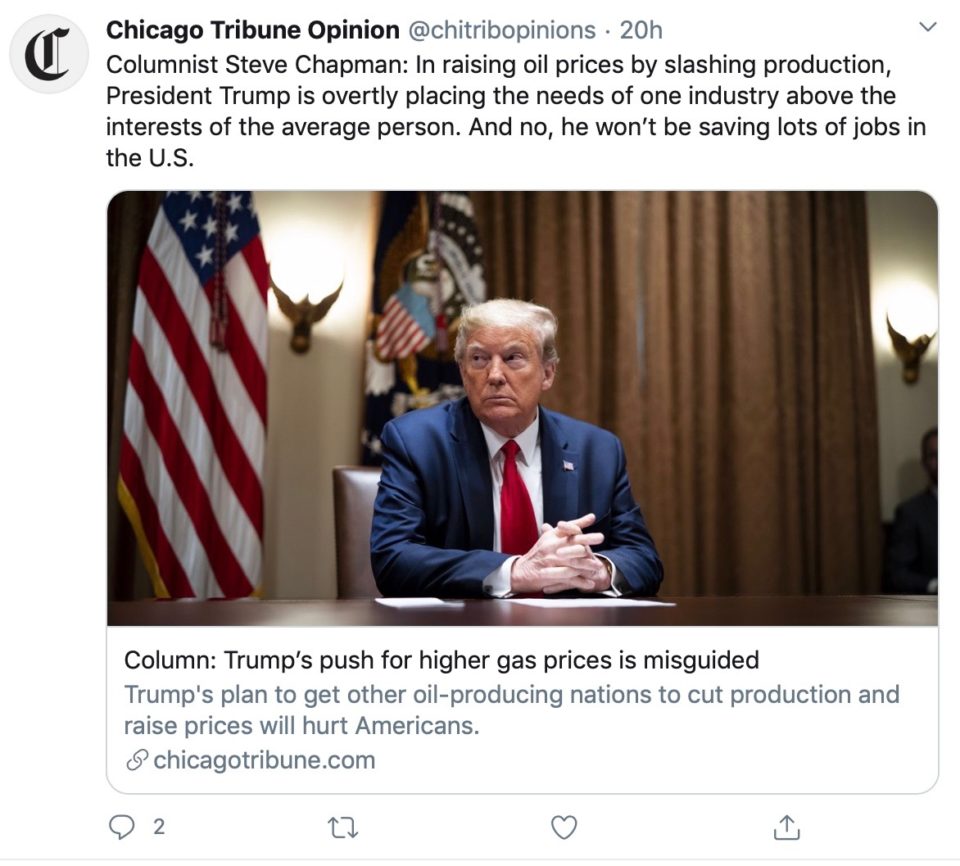
First of all, gasoline prices have actually declined significantly since the announcement of the deal to cut global oil production that the president helped broker. Pump prices could even drop below $1 a gallon, as oil prices continue to be extremely low due to the unprecedented demand shock attributable to the coronavirus pandemic.
Any policy aimed at deliberately raising gasoline prices would be insane to say the least – especially in an election year – and to suggest it was the president’s intent to do so is disingenuous. That is just one reason the columnist’s argument that the president’s actions were “overtly placing the needs of one industry above the interests of the average person” is also misleading.
It is important to remember why gasoline prices have been affordable for Americans for so long in the first place. U.S. oil and natural gas industry innovation over the past decade has allowed the United States to emerge as the world’s leading producer, become a net petroleum exporter, slash OPEC imports by 75 percent and make $3 gasoline a distant memory. And not only has the U.S. oil and natural gas industry kept pump prices low for American consumers, it is responsible for far more jobs than the columnist indicates.
The columnist’s states there are “only about 145,000” oil and gas extraction jobs in the U.S. But the upstream industry is actually directly responsible for more than three times that number of jobs, according to a recent Texas Independent Producers and Royalty Owners report. That report shows that the U.S. oil and natural gas industry directly employs more than 880,000 Americans overall, including 14,000-plus Illinoisans. Most of these jobs are high-skill, high-demand occupations, which explains why the average oil and natural gas industry wage is more than twice the private sector average. These jobs don’t exist in a vacuum, either. They bolster other industries, which is why the American Petroleum Institute estimates the industry supports 10.3 million U.S. jobs.
All this considered, a real gift to Russia and Saudi Arabia would be allowing the U.S. oil and natural gas industry to collapse and enabling hostile – and far less environmentally conscious – nations to reclaim the global market share they lost when the United States emerged as the world’s top producer.
IPRB Letter to Gov. Pritzker: Oil and Natural Gas Industry Indeed 'Essential'
April 2, 2020
The Honorable Governor JB Pritzker
207 State House
Springfield, IL 62702
Dear Governor Pritzker,
I wanted to take a moment to thank you for designating the Illinois oil and natural gas industry as an “essential” industry in your recent shelter-in-place executive order. This has allowed our industry’s 14,000 workers carry out necessary day-to-day operations to help the state combat the COVID-19 crisis.
As your executive order correctly acknowledges, it is indeed essential for oil and natural gas workers to be able to execute their daily responsibilities in order to produce and transport the products and services Illinoisans need during these trying times. In addition to providing fuels and manufacturing feedstock necessary to transport and produce essential products and services, oil and natural gas are also critical to providing our healthcare industry the tools it needs to fight this pandemic.
IV bags, ventilator machines, hospital gowns, latex gloves and the 3.5 billion face masks used by medical professionals each year are comprised of or include components of single-use plastics. Doctor’s scrubs, sterilization trays and monitors are also made of plastic or include petroleum products. Even hand sanitizers, soaps and some medicines are derived from petroleum, while critical procedures such as X-rays and MRIs would not be possible without oil and gas. Petroleum-based technology such as computers and cell phones also allow an unprecedented number of people to work from their homes and adhere to the social distancing safety precautions you have mandated.
I encourage your staff to reach out at any time for more information on the essential nature of the Illinois oil and natural gas industry and petroleum in general.
Sincerely,
Seth Whitehead
Executive Director, Illinois Petroleum Resources Board




